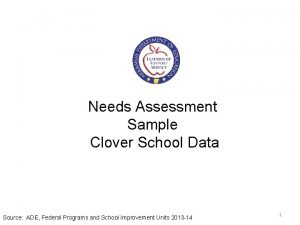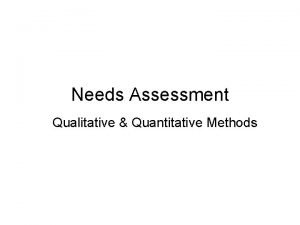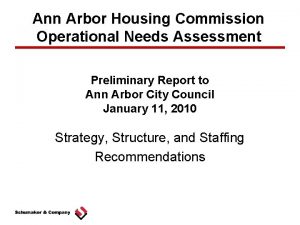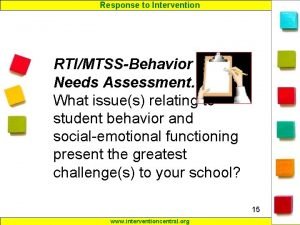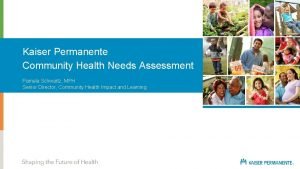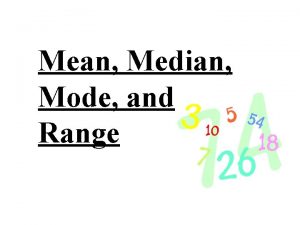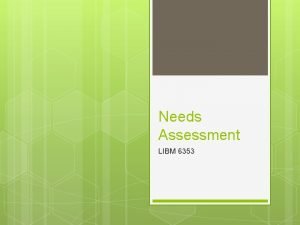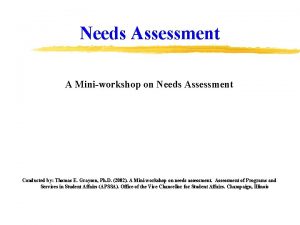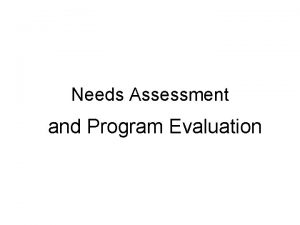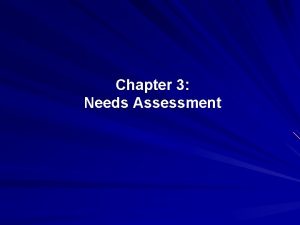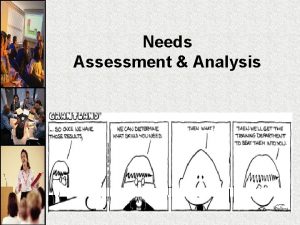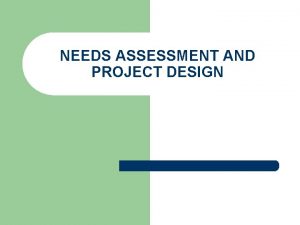ASSESSMENT OF CLIENT NEEDS What does it mean























- Slides: 23

ASSESSMENT OF CLIENT NEEDS

What does it mean to assess? � One of the definitions given in the Webster’s dictionary is to find out or decide the importance, size or value of something such as assessing a problem. � Providers and their staff provide services to clients in their homes and therefore always assessing what is going with the client physically, mentally as well as in their environment.

� Remember – � Clients receiving home and community based services must meet the same level of need as someone who is in a nursing home or facility for individuals with intellectual disabilities. � Staff going into the client’s home are the eyes and ears who can report what is observed or heard that should be reported so that the client’s needs can be addressed in a timely manner. Some clients are non-verbal or have communication deficits and cannot convey what their needs are.

� Failure to assess and to timely report changes in a client’s health status is one of the primary reasons immediate jeopardy, actual harm and other types of negative outcome to clients occur.

� � � Examples of incidents that should be reported immediately: Falls Burns Skin breakdown or wounds Pain Change in mental status

Who is responsible for assessing the client? • • • Direct care staff who are in the client’s home providing personal care services Supervisors who go into the home to make observations, review documentation and speak with the client and/or their family Administrators who are responsible for the overall operations of the agency and the care provided to clients served

• • Support Coordinator who develops the CPOC that addresses services needed by waiver participants to support them in the community. State contractors such as Xerox/Conduent who develop service plans for clients receiving LT-PCS services.

What are the provider’s responsibilities � � Assessing a client’s needs prior to admission and thereafter as the client’s needs change; Knowing the health care needs of the clients they serve; Having a system in place to assure referrals are made to the appropriate licensed medical practitioners as necessary so that the client receives needed care and services in a timely manner; Communication with other provider entities that may be involved in the client’s care concerning the client’s health care needs and the services that each is responsible for initially and on-going

� � � Assuring that direct care staff are trained and knowledgeable to perform the duties they are assigned, that they know when, what and to whom to report signs and symptoms of illness observed and they know when to call 911. Having agency policies and procedures on responding to emergencies and that staff know what the policies are. Providing adequate supervision. The frequency of supervision should be determined based upon the client’s individual situation and needs and not just the minimum required by the regulations. Supervision is one of the most important things a provider can do.

What do the regulations say about assessment? � Assessment of client needs is addressed in both the HCBS licensing standards published January 20, 2012 and in the Direct Service Worker Registry rule most recently published June 20, 2016. We will speak more about the Direct Service Worker Registry rule when we address to RN delegation.

HCBS Licensing Standards � Section 5039 Part C, 1 through 4, in HCBS licensing standards addresses Assessment of Needs. The intent of this section of the regulations is to assure that the provider has the capacity to meet the needs of the client before admitting them for services. The assessment of client needs shall include at a minimum, a risk assessment. The risk assessment shall be conducted prior to admission and at least annually thereafter. It may be conducted more often as the client’s needs change.

� � � The risk assessment shall address the client’s home environment, medical diagnosis, medications, treatments, the client’s need for assistance with activities of daily living, instrumental activities of daily living, communication, social and behavioral needs. Components of the risk assessment, may be addressed through either an assessment conducted by the HCBS provider utilizing an assessment tool that they developed, an assessment conducted by a support coordinator for waiver clients used to develop the CPOC such as the MDS-HC or the SIS-LA Plus or an assessment conducted by a State Medicaid contractor such as for LT-PCS clients.

� Through the risk assessment, the provider determines the needs of the client and whether they have the capacity to meet those needs. A provider should not admit a client without a thorough assessment of the client’s needs. The provider must determine whether they have the capacity to provide the care and services needed by the client to assure health and safety.

� � � The provider must assure that if staff need additional client specific training to respond to special needs of the client, that it is provided. Will additional resources be needed to provide the services according to the plan of care? Examples of clients with special needs may be those with behavioral issues who require behavior support plans or those with complex medical needs that may require skilled nursing.

� Don’t be placed in a position of becoming aware of a problem after a client is admitted which presents challenges beyond what you and your staff can safely handle.

� Part C (2) of the licensing standards say that if medical issues are identified in the assessment, a licensed physician or licensed registered nurse shall perform a medical assessment to determine necessary supports and services which shall be addressed in the individual service plan

� If the client has health care needs identified in the risk assessment that require the regular management or oversight of a licensed physician, registered nurse (RN), psychologist or other licensed medical practitioner (Nurse Practitioner, Physician’s Assistant), a medical assessment shall be performed to determine necessary supports and services which shall be addressed in the Individual Service Plan (ISP).

� Examples of health care needs may include treatments such as medications, wound care, respiratory care, physical or occupational therapies or blood glucose monitoring for insulin dependent diabetics. The medical assessment may be in the form of a 90 -L, physician office visit, home health plan of care, hospital discharge summary or other entry by a licensed medical practitioner.

� If the client has a change in health status, the provider shall ensure that the client receives an assessment of his/her change in health status by a licensed physician, RN or other licensed medical practitioner as well as ongoing assessment of changes in health status as deemed medically necessary or as specified within the plan of care.

� � What is a change in health status? “A change in condition that will not normally resolve itself without further intervention”.

� � When a change in health status occurs, assessment by the licensed medical practitioner may be accomplished in a number of ways such as through a physician’s office visit, ER visit, hospital admission, home health or the provider’s RN. The important thing to remember is that the change in the client’s condition is reported so that the client can receive medical attention timely. The provider should have a policy on when and to whom staff are to report changes to.

� � � What can the provider do to avoid deficiencies in the area of client assessment? Staff training Supervision Good documentation by direct support staff regarding the services provided and the client’s response, their observations and communications with the client Prompt reporting of any incidents that may take place while direct care staff are on duty

� Health standards Home and Community Based Services web page for Provider Training Resources � http: //dhh. louisiana. gov/index. cfm/page/1790
 Client needs assessment
Client needs assessment Vmatrix server manager
Vmatrix server manager Linux leger
Linux leger Application layer
Application layer Primary needs and secondary needs
Primary needs and secondary needs Primary needs and secondary needs
Primary needs and secondary needs Simple claustral complex
Simple claustral complex Strategic gender needs and practical gender needs
Strategic gender needs and practical gender needs Procedure of need analysis in esp
Procedure of need analysis in esp What is absolute mean deviation
What is absolute mean deviation What does mean mean
What does mean mean Say mean matter examples
Say mean matter examples What is nylon drape
What is nylon drape Assessment questions social work
Assessment questions social work Biochemical data, medical tests, and procedures (bd)
Biochemical data, medical tests, and procedures (bd) Adult needs and strengths assessment
Adult needs and strengths assessment Ade needs assessment
Ade needs assessment Difference between qualitative and quantitative
Difference between qualitative and quantitative Community needs assessment steps
Community needs assessment steps Challenges of needs assessment
Challenges of needs assessment Housing needs assessment
Housing needs assessment Mtss needs assessment
Mtss needs assessment Pamela schwartz kaiser
Pamela schwartz kaiser Transportation needs assessment
Transportation needs assessment
















